ROVs Hercules & Argus Recovery Updates
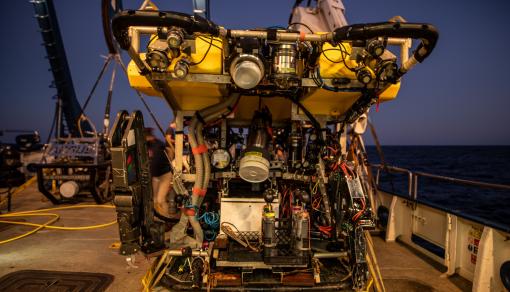
September 3, 2021
One week after remotely operated vehicles (ROVs) Hercules and Argus became detached from the cable that connects them to E/V Nautilus, Ocean Exploration Trust is relieved to announce that as of September 2nd, 2021, both of our beloved vehicles have been recovered from the seafloor and are back onboard Nautilus. In two ROV dives over the course of 26 hours, Woods Hole Oceanographic Institution’s (WHOI) ROV Jason team deployed their vehicle from the University of Washington’s R/V Thomas G. Thompson, and were able to work with the team aboard Nautilus to safely rescue both vehicles. These operations occurred in water over 2100 meters deep at Endeavour, approximately 200 km offshore British Columbia, Canada.
On the first reconnaissance dive on September 1st, ROV Jason was quickly able to locate the vehicles utilizing the coordinates of their last known location on August 26th and by pinging Hercules’s Sonardyne USBL navigational beacon utilized by both WHOI and OET. The negatively-buoyant towsled ROV Argus was found partially dug into the rubble of the basaltic terrain of Endeavour still connected to positively-buoyant ROV Hercules floating 60 meters above at the end of the umbilical tether. After both vehicles were prepared and rigged for recovery by attaching beacons, adjusting flotation, and preparing lift straps, ROV Jason returned to the surface to prepare for a second dive timed to release and recover Hercules at the surface at daybreak.
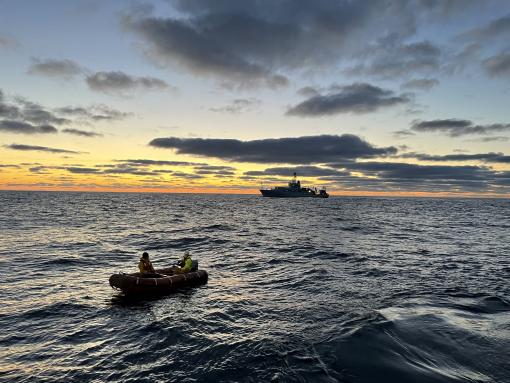
On the second dive on September 2nd, ROV Jason descended equipped to sever the tether connecting Hercules and Argus using a hydraulic band saw, releasing Hercules to free-float to the surface. Once released, ROV Hercules ascended at a rate over 30 meters per minute, more than double the normal ascent speed. At sunrise, the ROV reached the surface where it was hooked into a recovery line using the E/V Nautilus’s small boat. Approximately two and a half hours after being released from the seafloor and 167 hours since being disconnected from the ship, Hercules was craned back aboard Nautilus.
The team aboard Nautilus then used the ship’s traction winch to deploy over 2000 meters of cable, typically attached to Argus during normal operations, to the seabed rigged with tracking beacons, a lift line for Argus, and a shackle to connect the lift line to the Argus rigging that the ROV Jason team had put in place during the prior dive. ROV Jason pilots connected the shackle to the lift straps threaded through the frame of Argus, and Nautilus was able to recover the vehicle by reeling it in with the winch and transferring Argus to the crane via the lift line. With both ROVs safely onboard, the team aboard Nautilus began the long process of thoroughly checking and documenting the condition of both vehicles and their many components. This process and maintenance will continue through the coming weeks. After less than 30 hours on site and a proper farewell salute of the vessels’ horns, the team aboard R/V Thompson began their transit to Newport, OR to demobilize their more than month-long Ocean Observatories Initiative expedition that was extended to aid in this effort. E/V Nautilus departed shortly after for Port Angeles, WA to demobilize this rescue mission.
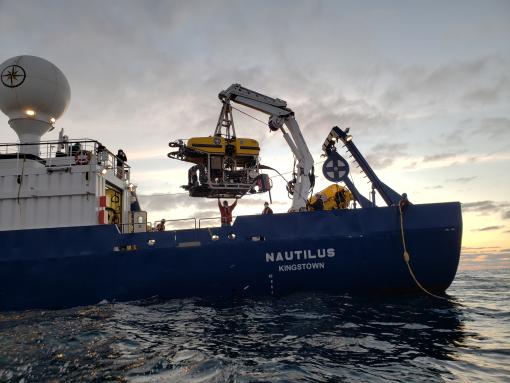
In the deep-sea exploration and research community, we often talk about what it takes to pull off a successful expedition and it always, no matter the complexity of the mission, boils down to teamwork and collaboration. The recovery of both of OET’s ROVs from the seafloor today was precisely that and we are forever grateful to the many individuals and groups that aided in the planning, permissions, and the expedition itself.
Our gratitude for the success of this operation goes out to the many partners and collaborators who contributed their assistance, equipment, and expertise. We are especially thankful to the National Science Foundation, University-National Oceanographic Laboratory Systems, University of Washington, WHOI National Deep Submergence Facility, the WHOI ROV Jason team, Ocean Observatories Initiative, Office of Naval Research, the crews and expedition teams of R/V Thomas G. Thompson (TN-393C) and E/V Nautilus (NA129 & NA129b), Maritime Management, Leviathan, Ocean Networks Canada, Fisheries and Oceans Canada, Oregon State University, Schmidt Ocean Institute, NOAA Ocean Exploration, NOAA Office of National Marine Sanctuaries, NOAA Ocean Exploration Cooperative Institute, and OET staff and contractors.
In addition to the oceanographic and research community, students, educators, and Nautilus Live fans from around the world have remotely joined in on this recovery mission, sending well wishes throughout the week. Our team deeply appreciates this encouragement and is inspired by the care and connection millions of viewers feel for the deep ocean, including ROV Hercules and Argus. With the vehicles back onboard, we look forward to the continuation of the 2021 expedition season as the team launches a NOAA Ocean Exploration Cooperative Institute seafloor mapping expedition starting September 4th from Washington to southern California. See where Nautilus is heading next.
September 1, 2021 | 11:00pm PDT
In the six days of planning leading up to this ROV rescue operation, we envisioned the best case scenario with regards to vehicle orientation on the seafloor would be that ROV Hercules would be anchored by ROV Argus to the seafloor and resting directly above it connected by tether. That is precisely the arrangement we found the vehicles in today, which allowed for the ROV Jason team aboard R/V Thompson to expertly and efficiently check off the list of tasks needed to prepare the vehicles for recovery to E/V Nautilus.
R/V Thompson arrived on site at Endeavour around 11:00am PDT today to launch the first ROV Jason dive to assess the location, orientation, and condition of ROVs Hercules and Argus. With the Nautilus team remotely watching operations, ROV Jason descended approximately 2200m at the location where we logged the last known coordinates of Hercules and Argus. ROV Jason quickly observed ROV Hercules hovering upright above the seafloor with ROV Argus located below Hercules, resting upright on the seafloor.
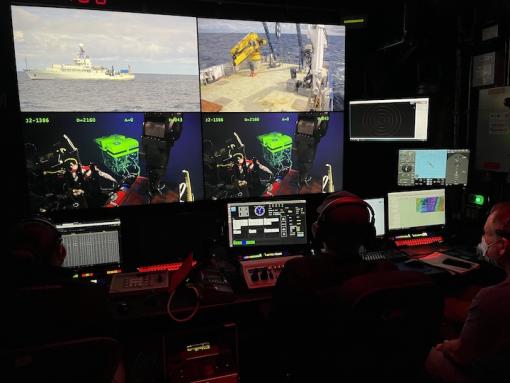
In order to bring Hercules and Argus to the surface, multiple steps were taken today to prepare both vehicles for recovery. The tether between Hercules and Argus will be cut, which will result in Hercules free floating to the surface to be recovered by E/V Nautilus. To prepare for this, the ROV Jason team attached a beacon and extra flotation to Hercules for added buoyancy and tracking ability. The team also prepared the 60m-long tether for cutting by hydraulic band saw by clearing the tether of lift lines that are typically attached to it. Once preparations to recover Hercules were complete, the Jason team descended to prepare Argus for recovery. Straps were threaded through the frame of Argus to ensure the vehicle is supported as it is lifted off the seafloor during recovery by the winch and crane aboard Nautilus.
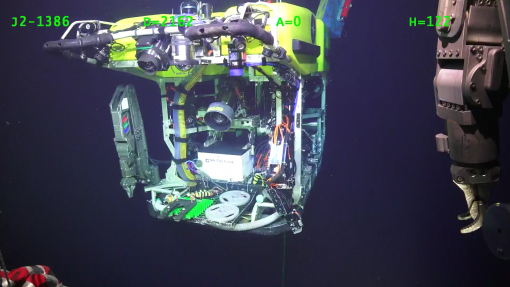
On September 2nd, the Jason team will launch a second dive in the early morning with an anticipated time at the seafloor around 4:30am PDT. The objective of the dive will be for ROV Jason to sever the 60-meter tether between ROVs Hercules and Argus, which will release Hercules to the surface to be recovered by E/V Nautilus. After the Nautilus team recovers Hercules by small boat and the ship’s crane, Nautilus will lower a recovery line for Argus to the seafloor, and Jason will attach the line to Argus for recovery back aboard Nautilus.
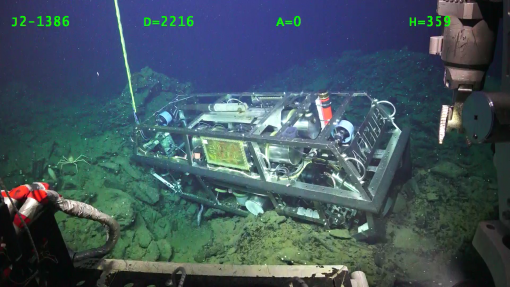
Due to the positive progress of our recovery plans, we are pleased to be able to live stream tomorrow’s recovery operations, including the ROV Jason underwater feeds from R/V Thompson, as well as the shipboard operational cameras aboard E/V Nautilus. We continue to be so thankful for the support and encouragement of our partners, collaborators, expedition participants, and Nautilus Live viewers.
September 1, 2021 | 10:00am PDT
Last week on Thursday, August 26th, 2021, our remotely-operated vehicles (ROVs) Hercules and Argus became detached from the cable connecting them to E/V Nautilus while conducting a dive off the coast of Vancouver Island, British Columbia. While the Ocean Exploration Trust (OET) team continues to investigate the cause of the incident, we still do not know the precise reason for the failure between the cable termination and ROV Argus. As this event curtailed our ability to continue the prior expedition with our partners at Ocean Networks Canada (ONC), we transited into port in Sidney, British Columbia, on August 29th to offload ONC personnel and equipment. After an additional port stop in Port Angeles, Washington for further personnel transfer and onboarding of equipment, we are in transit to start recovery efforts.
We are grateful to be able to launch this effort so quickly thanks to the herculean rallying of support from our partners, colleagues, and collaborators. Now, we are proceeding with the following recovery plan with the assistance of the University of Washington’s R/V Thomas G. Thompson and Woods Hole Oceanographic Institution’s ROV Jason. Over the last six days, the expedition teams aboard E/V Nautilus and R/V Thomas G. Thompson as well as those on shore have worked tirelessly reviewing many possible scenarios to develop a plan to rescue both ROVs from the seafloor as well as get all necessary logistics in place. Additional support from Woods Hole Oceanographic Institution, University of Washington, National Science Foundation, Ocean Networks Canada, University-National Oceanographic Laboratory System, Ocean Observatories Initiative, Oregon State University, Office of Naval Research, and Schmidt Ocean Institute have been instrumental in enabling us to develop a recovery plan over a very short amount of time. We are especially appreciative of Dr. Deb Kelley, Dr. Orest Kawka, and the team aboard R/V Thompson on the VISIONS’21 cruise supporting the Ocean Observatories Initiative, who have extended their already lengthy time at sea to accommodate the recovery mission. As with all expeditions, our plans are subject to changing weather conditions and operational considerations, as the safety of both shipboard teams is our highest priority.
Starting late on August 31st, E/V Nautilus departed Port Angeles, Washington to transit to Endeavour, where we logged the last known depth and location of ROVs Hercules and Argus. On September 1st, Nautilus will join R/V Thomas G. Thompson and ROV Jason onsite. ROV Jason, operated by a team from Woods Hole Oceanographic Institution’s Deep Submergence Lab, will conduct visual seafloor surveys and coordinate with the team aboard Nautilus to refine vehicle recovery options and operations and then proceed with an attempt to fully recover both vehicles utilizing both vessels. Due to vessel schedule constraints, we have up to late morning on September 3rd with both vessels on site to complete the recovery mission.
We are so thankful for the outpouring of support we have received from the oceanographic community and from our dedicated Nautilus Live viewers, for whom Hercules and Argus open up a window to the deep sea. We will continue to share daily updates on NautilusLive.org as our recovery plan continues. Shipboard cameras on R/V Thomas G. Thompson and E/V Nautilus will be streaming as the vessels are in transit to begin operations. Due to the sensitivity of operations, underwater live streaming to the public will be unable to be supported by either ship. Thank you for your patience and support as we navigate this unique and challenging situation. We look forward to telling you the full story and sharing documentation of what we hope will be a successful recovery of both vehicles in the very near future.
August 27, 2021
On Thursday, August 26, 2021 around 2pm PDT, remotely-operated vehicles (ROVs) Hercules and Argus became detached from the cable connecting them to E/V Nautilus at a depth of 2220m off the coast of Vancouver Island, British Columbia. The Ocean Exploration Trust team is now investigating the cause of the detachment and transitioning to a plan to recover the vehicles, which we believe are still tethered together and residing on the seafloor at a known depth and location. This incident occurred entirely underwater and at no time was an unsafe situation for the team onboard. While this is a rare event to happen, this is not the first of these types of situations within the field of ocean exploration and research. We are grateful to our partners, colleagues, and collaborators that have rallied to support us in our recovery efforts.
At the time of this event, Ocean Exploration Trust was 21 days into a 28-day expedition supporting the University of Victoria’s Ocean Networks Canada offshore observatory located off the west coast of British Columbia, Canada.
Updates on this expedition will be available at www.nautiluslive.org and www.oceannetworks.ca.
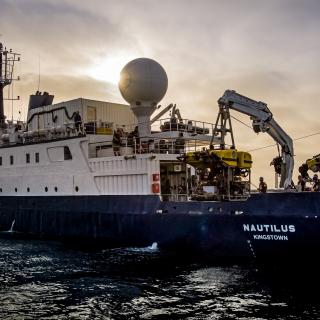
ROV Recovery at Endeavour
On Thursday, August 26, 2021, remotely-operated vehicles (ROVs) Hercules and Argus became detached from the cable connecting them to E/V Nautilus at a depth of 2220m off the coast of Vancouver Island, British Columbia.

